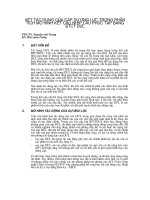Short Reach Mode
Bạn đang xem bản rút gọn của tài liệu. Xem và tải ngay bản đầy đủ của tài liệu tại đây (160.63 KB, 4 trang )
WHITE PAPER
Short Reach Mode
10 Gigabit Ethernet Over Copper
10 Gigabit Ethernet Over Copper
Short Reach Mode
With Tehuti Networks and Applied Micro Circuits Corporation (AMCC)
A late addition to the recently released IEEE 802.3an standard for
10GBASE-T, Short Reach Mode is designed to run 10 gigabits per second
(10 Gbps) with presumably less power than the full power version
of 10GBASE-T. Short Reach Mode was added for cost-effective early
implementations of 10 Gigabit Ethernet over copper in the data center.
This white paper addresses the technology behind Short Reach 10GBASE-T
and helps guide you in properly implementing a 10GBASE-T infrastructure.
Within this paper you will learn:
• What is 10GBASE-T Short Reach Mode and why was it added to the
standard
• Why Short Reach Mode requires Augmented Category 6 (Cat 6A) or
ISO Class F cabling
• What are the advantages and disadvantages of Short Reach Mode
• What applications are best suited for Short Reach Mode
Page 3
10 Gigabit over Copper:
Short Reach Mode
Following nearly four years of intensive development,
the IEEE standards association recently ratified the 10
Gigabit Ethernet (10GBASE-T) standard IEEE 802.3an,
which specifies 10 Gbps data transmission over four-pair
copper cabling. Short Reach Mode was a late addition to
the standard, and many in the industry are unaware of
its requirements, potential advantages, and applications.
This white paper addresses the technology behind Short
Reach 10GBASE-T and helps guide you in properly
implementing a 10GBASE-T infrastructure.
What is Short Reach Mode?
The 10GBASE-T optional Short Reach Mode, also referred
to as Low Power Mode, is designed to run 10 Gbps with
less power than the full version of 10GBASE-T. Short
Reach Mode is based on a cabling link of 30 meters Cat
6A or ISO Class F (shielded) cabling. The link consists of
two connectors, 10 meters of patch cords, and 20 meters
of horizontal cabling (see Figure 1).
Figure 1: Short Reach Mode Test Confi guration
Why was it added to the standard?
Some implementations of the full-power version of the
10GBASE-T standard may require as much as 10 to
15 watts of power to deliver 10 Gbps on a 100 meter
channel using Cat 6A cabling or on a 55 meter channel
using Category 6 cabling. However, the widely deployed
X2 pluggable modules have a power limit of 4 watts.
Power requirements greater than 4 watts would therefore
sacrifice the ability to use existing X2 ports.
The IEEE 802.3an task force identified the need to
satisfy a large portion of the market with a mode that
would enable 10GBASE-T physical layer (PHY) devices
to be deployed inside X2 modules. Instead of specifying
a power limit, which changes as process technologies
improve, a distance of 30 meters was selected to address
the data center and server cluster applications. The result
was the addition of a 30-meter test channel that became
known as Short Reach Mode.
As 10GBASE-T PHY devices appear in the marketplace,
it is expected that equipment vendors will soon be able
to develop PHYs that can utilize less power to support
10 Gbps on all ports over greater distances. In the
interim, Short Reach Mode enables customers who only
require 30 meter cabling distances to implement lower
power equipment. The lower power requirements and
corresponding higher port densities achieve improved
power load per port and price-performance per port.
Why does it require Augmented Category 6 or
Class F cabling?
The IEEE 802.3an task force determined that high-
performance cabling simplifies power reduction in the
PHY devices for Short Reach Mode. Existing Category
6 cabling could potentially require more than 4 watts
of power due to the characteristics of the cable and
connectors. Because Cat 6A cabling and ISO Class F
cabling offer much better attenuation and crosstalk
performance than existing Category 6 cabling, the
standard specified Short Reach Mode for these two types
of cabling.
What are the advantages and disadvantages?
Data center and cluster computing applications will be
some of the first applications to deploy 10 Gbps speeds
and will require 30 meters or less cabling distances.
The advantages of Short Reach Mode include:
• Ability to use existing X2 ports on switches and
adapters
• Reduced power and cooling requirements
• Better performing cabling to support reduced power
and increased port density
The disadvantages of Short Reach Mode include:
• 30 meter distance limitation
• Not specified for Category 6 cabling
• 2-connector channel requires interconnect vs. cross-
connect scenario
The result
It is expected that the 10 Gigabit Ethernet market will
ramp up quickly with the introduction of 10GBASE-T
PHY devices that offer the ability to transport 10 Gbps
over four-pair copper cabling. The first generation of
10GBASE-T PHY devices may not support 10 Gbps
to 100 meters due to power requirements. Until this
technology matures to provide lower power per port,
Short Reach Mode is the cost-effective alternative to
deploying 10GBASE-T while addressing the demand of
the data center and cluster applications.
It's important to remember that Short Reach Mode is
only supported by Cat 6A and ISO Class F cabling – not
existing Category 6. Because ISO Class F cabling is a
pair-in-metal-foil shielded cable that is costly and time
consuming to install, Cat 6A cabling is the best choice for
supporting 10 gig over copper in today's data center and
computer cluster applications.
10 Gigabit Over Copper - Short Reach Mode
2 connector topology
A B C
5 m 20 m 5 m
Authors
Brad Booth, Senior Principal Engineer, AMCC
Brad Booth is a senior principal engineer at Applied Micro Circuits Corporation (AMCC) and drives
alignment of AMCC strategic planning to industry initiatives and standards. Previously, Brad was the
director of advanced products for Quake Technologies and the manager of Intel’s Enterprise Interconnect
Standards Team. Brad chaired the IEEE Std. 802.3an™-2006 (10GBASE-T) project, which developed a
standard for 10 Gigabit Ethernet over twisted-pair balanced copper cabling. Prior to that, Brad was the
editor-in-chief for IEEE Std. 802.3ae™-2002 for 10 Gigabit Ethernet on fiber optic cabling. Currently,
Brad serves as the president for the Ethernet Alliance. Previously, he has held positions as director and
as VP of technology for the 10 Gigabit Ethernet Alliance. In 2003, Brad received recognition as a senior
member of the IEEE.
Blaine Kohl, Vice President of Marketing, Tehuti Networks
Blaine Kohl has over 14 years of experience with networking and communications products and has
specific expertise in developing and launching new technologies and products. Blaine also currently
serves as the Vice President of Marketing for the Ethernet Alliance, an industry consortium dedicated
to the promotion of Ethernet technologies. She last served as the Vice President of Marketing for
Bandspeed. Prior to that she was Intel's Director of Marketing for iSCSI, 1Gigabit and 10 Gigabit
Ethernet product lines where she was pivotal in the development of the technologies and products. Prior
to Intel, Blaine was at Level One Communications, Jato Technologies and Motorola.
John Schmidt, Senior Product Manager and Business Development, ADC
John Schmidt is the Product Manager for Structured Cabling at ADC. John has been with ADC for
10 Years in a variety of Design Engineering and Product Management roles. He is the author of
several articles, white papers, and presentations related to the design of telecommunications and data
networks. John has a Bachelor of Science Degree in Engineering from the University of Minnesota and
has 10 patents for telecommunications and network equipment design.
Web Site: www.adc.com
From North America, Call Toll Free: 1-800-366-3891 • Outside of North America: +1-952-938-8080
Fax: +1-952-917-3237 • For a listing of ADC’s global sales office locations, please refer to our web site.
ADC Telecommunications, Inc., P.O. Box 1101, Minneapolis, Minnesota USA 55440-1101
Specifications published here are current as of the date of publication of this document. Because we are continuously
improving our products, ADC reserves the right to change specifications without prior notice. At any time, you may
verify product specifications by contacting our headquarters office in Minneapolis. ADC Telecommunications, Inc.
views its patent portfolio as an important corporate asset and vigorously enforces its patents. Products or features
contained herein may be covered by one or more U.S. or foreign patents. An Equal Opportunity Employer
104098AE 1/07 Original © 2007 ADC Telecommunications, Inc. All Rights Reserved
WHITE PAPER
For information on... See the following...
10GBASE-T standard www.ieee802.org\3\an
X2 module www.2msa.org









